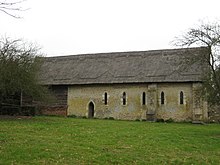Robert de Vere, 5th Earl of Oxford
Robert de Vere, 5th Earl of Oxford (* around 1240; † before September 7, 1296 ) was an English magnate .
origin
Robert de Vere came from the Anglo-Norman de Vere family , who had their headquarters in Hedingham , Essex . He was the eldest son of Hugh de Vere, 4th Earl of Oxford and his wife Hawise de Quincy . After the death of his father in 1263 he inherited his estates, the title Earl of Oxford and the inheritance of Chamberlain . Despite the title and office, however, he was a rather insignificant nobleman with very few possessions that did not correspond to his class. Although the office of Chamberlain was one of the highest state offices , it had lost its administrative functions in the previous century and was limited to purely ceremonial tasks in the 13th century. However, the incumbent still had priority at the royal court.
Role during the Second War of the Barons
De Veres father already had the nobility opposition to King Henry III. supported. After Robert de Vere took over his inheritance at the end of 1263, he also supported the rebels under Simon de Montfort, 6th Earl of Leicester , during the open Second War of the Barons . In May 1264 he was knighted by Montfort before the Battle of Lewes . De Vere belonged to the army of Simon de Montfort the Younger , which was surprised and defeated on August 1, 1265 in front of Kenilworth Castle by the army of the heir apparent Edward . After the decisive victory of the royal party a few days later in the Battle of Evesham , the office of Chamberlain and the title of Earl of Oxford was withdrawn from him, and he lost extensive possessions such as the Honor of Oxford to Roger Mortimer . Other lands fell to Gilbert de Clare, 3rd Earl of Gloucester. Under the terms of the Dictum of Kenilworth , enacted in 1266 , he was able to buy back most of his possessions and was again recognized as an Earl. The fine de Vere had to pay Mortimer for returning the Honor of Oxford was tied to a marriage contract according to which one of Mortimer's daughters married de Vere's eldest son. The office of Chamberlain was only achieved by his grandson John de Vere, 7th Earl of Oxford .
Next life
De Vere took part in King Edward I's campaign to conquer Wales from 1282 to 1283 . During the Franco-English War from 1294 he refused, together with the Earl of Arundel and other magnates, to participate in the campaign in Gascony in 1294 . After his death in 1296 he was buried in the Earls Colne family priory in Essex. After the Reformation, his funerary monument was moved to St Stephen's Chapel in Bures St Mary in Suffolk .
Marriage and offspring
De Vere had married Alice de Sandford († before 1312), a daughter and co-heir of Gilbert de Sandford and his wife Lorette . He had several children with her, including:
- Robert de Vere, 6th Earl of Oxford (1257–1331) ∞ Margaret Mortimer († 1297)
- Hugh de Vere, 1st Baron Vere (1257 / 8–1319)
- Sir Alfonso de Vere († 1328) ∞ Jane Foliot
- Gilbert de Vere (around 1264–1289)
- Joan de Vere († 1293) ∞ William de Warenne († 1286)
- Hawise de Vere († after 1297)
Web links
- Cracroft's Peerage: Oxford, Earl of (E, 1142-1703)
- Robert de Vere, 5th Earl of Oxford on thepeerage.com , accessed August 31, 2018.
Individual evidence
- ^ Michael Prestwich: Edward I. University of California, Berkeley 1988, ISBN 0-520-06266-3 , p. 235
- ↑ Lord great chamberlains in the Oxford DNB. In: Henry Colin Gray Matthew, Brian Harrison (Eds.): Oxford Dictionary of National Biography , from the earliest times to the year 2000 (ODNB). Oxford University Press, Oxford 2004, ISBN 0-19-861411-X , ( oxforddnb.com license required ), as of 2004
- ^ Michael Altschul: A baronial family in medieval England. The Clares. The Johns Hopkins Press, Baltimore 1965, p. 99n
- ↑ JR Maddicott: Montfortians (act. 1258-1265). In: Henry Colin Gray Matthew, Brian Harrison (Eds.): Oxford Dictionary of National Biography , from the earliest times to the year 2000 (ODNB). Oxford University Press, Oxford 2004, ISBN 0-19-861411-X , ( oxforddnb.com license required ), as of 2004
- ^ JJ Crump: Mortimer, Roger (III) de, lord of Wigmore (1231-1282). In: Henry Colin Gray Matthew, Brian Harrison (Eds.): Oxford Dictionary of National Biography , from the earliest times to the year 2000 (ODNB). Oxford University Press, Oxford 2004, ISBN 0-19-861411-X , ( oxforddnb.com license required ), as of 2004
- ^ Michael Altschul: A baronial family in medieval England. The Clares. The Johns Hopkins Press, Baltimore 1965, p. 110
- ^ Michael Prestwich: Edward I. University of California, Berkeley 1988, ISBN 0-520-06266-3 , p. 281
- ^ Michael Prestwich: Edward I. University of California, Berkeley 1988, ISBN 0-520-06266-3 , p. 406
- ^ British Listed Buildings: Bures St. Mary: Chapel of St Stephen. Retrieved May 2, 2018 .
| predecessor | Office | successor |
|---|---|---|
| Hugh de Vere |
Earl of Oxford 1263-1296 |
Robert de Vere |
| personal data | |
|---|---|
| SURNAME | de Vere, Robert, 5th Earl of Oxford |
| ALTERNATIVE NAMES | Oxford, Robert de Vere, 5th Earl of |
| BRIEF DESCRIPTION | English nobleman |
| DATE OF BIRTH | around 1240 |
| DATE OF DEATH | before September 7, 1296 |
